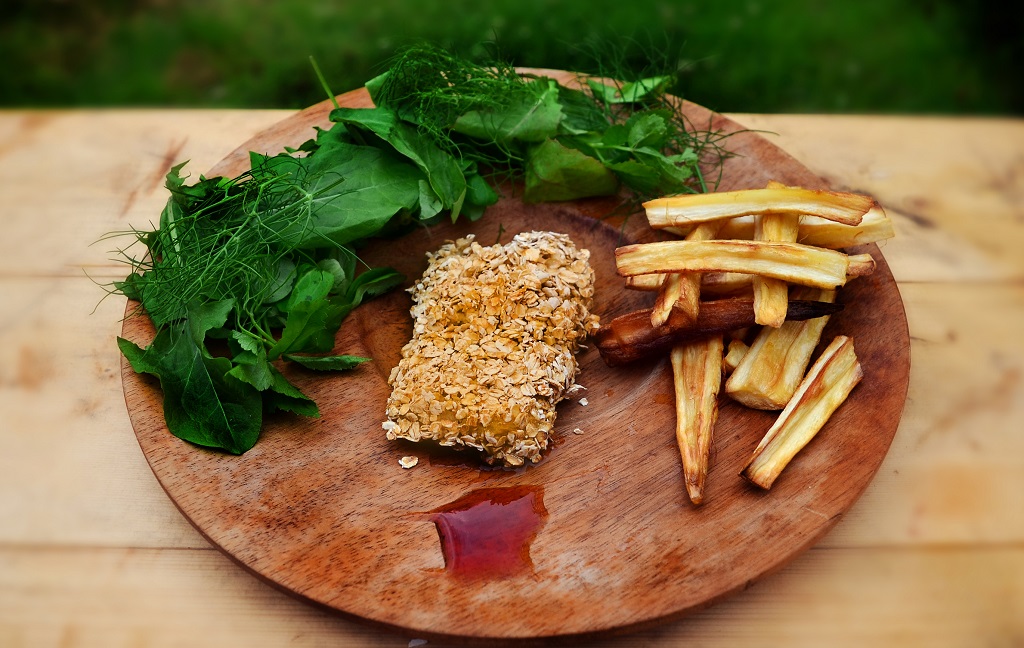Did you tune into our CastleFest panel show, Fact or Fake News earlier this week?
In the “Taste the Truth” round our contestants were treated to a feast inspired by Scottish history. Two of the dishes contained authentic historical flavours and backgrounds, but one was a red herring. It was their job to work out which!
Curious about our choice of courses and their context? Our chef, HES steward, reenactor and forager, Kat, tells us more (and shares the recipes!)
First Course: Monastic Fish and Chips
We thought we would ease the contestants in gently, so the first of our dishes was familiar-looking: a fish supper.
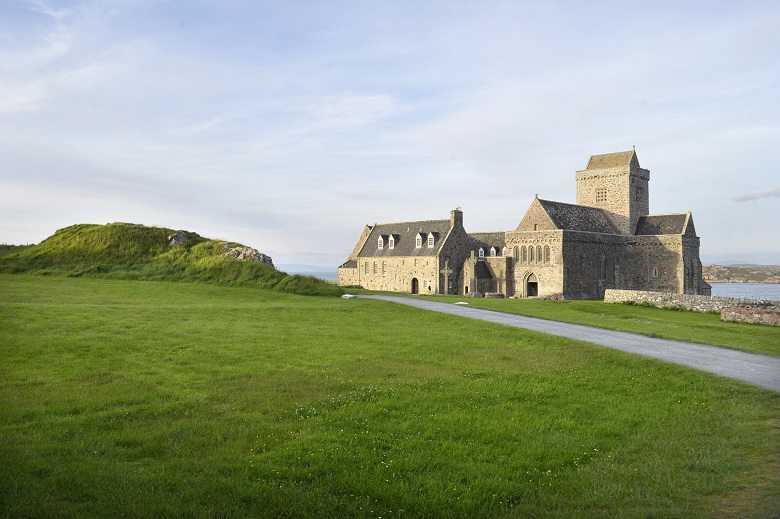
One of our dishes is inspired by life at abbeys like Iona
Modern fish and chips is thought to have been composed as a dish in the 1800s with the battered fried fish element having been introduced by Spanish and Portuguese refugees in the 1500s. But what if the monks of the 1300s had their own version?
Our Monastic fish and chips is inspired by abbey life in the 1300s. It’s made using cooking methods and ingredients available at the time through farming or foraging. Importantly, it’s also allowable under the strict rule of St Benedict (written in 516) which monks at Benedictine abbeys like Dunfermline and Iona would have lived their lives by.
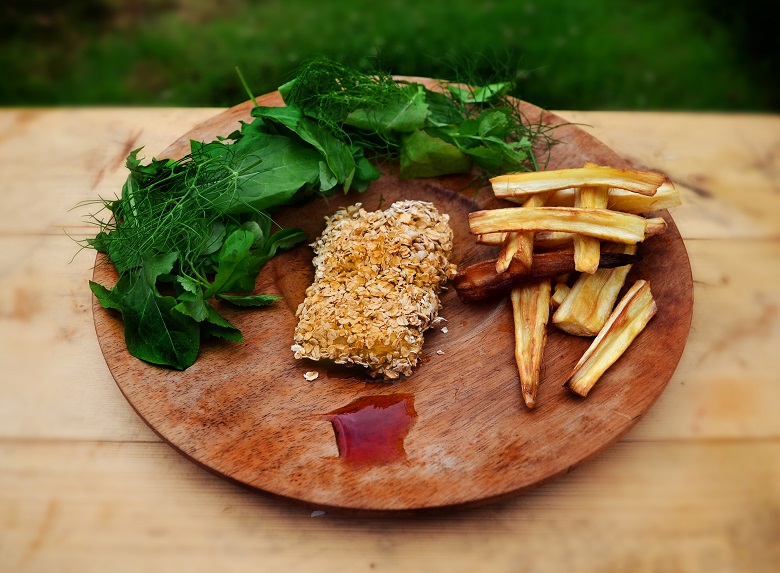
Fish and chips, but with a 12th century twist!
Fish played a large part in Benedictine diets, and a role on feast days in the Cistercian order, as meat from four legged animals was banned. The modern tradition of “fish Friday” is thought to have originated from this time as Friday was considered a fast day on which it was ok to eat fish.
There are examples of fish ponds having been built at many Abbey sites such as at Sweetheart Abbey. Other curious beasts classed as “fish” included ducks and even beavers.
The potato would not arrive ’til the 1600s but carrots and parsnips were grown in abbey gardens and plants like burdock could be foraged from the wilds and make a great alternative to potato chips.
Second Course: Medieval “Boiled Eggs”
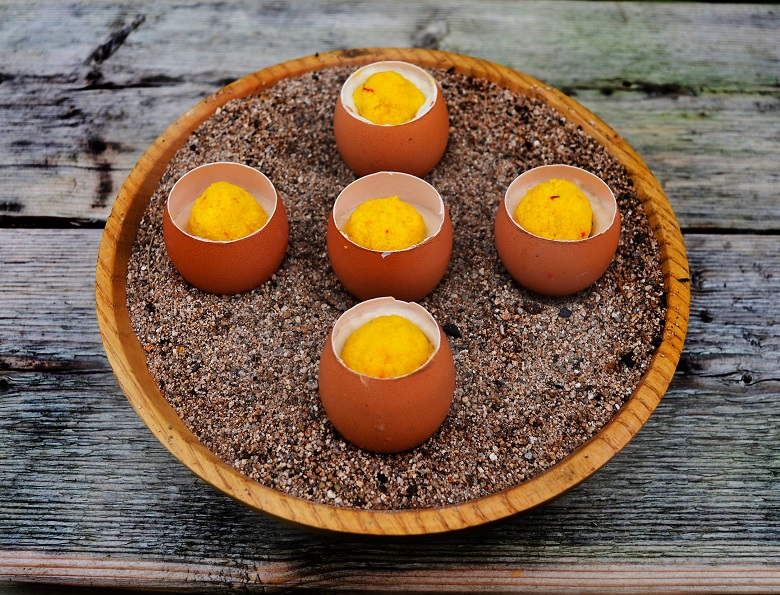
We move to the 1500s for our next dish – and it’s one fit for knights and nobility! This was a time when cooking was being used to impress, with expensive or rare ingredients to show off wealth.
Large and ostentatious menus often featured dishes known as “subtleties”. These impressive edible decorations used clever culinary techniques to play a trick on diners by pretending to be something else. So, without further ado, allow us to present our “boiled eggs”!

Other than the shells, the recipe contains no eggs and instead consists of two very expensive ingredients at the time, sugar and saffron, along with crushed almonds and almond milk set into a jelly which was done using “Isinglass” (the gas bladder of the sturgeon fish).
Other “subtleties” could have included pastry gardens filled with marzipan flowers, fruit made of meat, cooked mythical beasts and more! Certainly these eggs would not have been out of place at the elaborate three-day celebration Mary, Queen of Scots arranged for her son’s christening in 1566.
Third Course: Scots Explorer Pemmican
The third dish served to our brave contestants was from an entirely made-up recipe, Pemmican, a nutritious mix of fat, dried meat and berries, is an historically important part of indigenous cuisine in certain parts of North America.
We know that Scottish explorer Dr John Rae ate pemmican when exploring the Arctic. It was Rae, along with another prolific Scottish adventurer, Isobel Wylie Hutchison, that inspired our own version: “Scots Explorer Pemmican”.
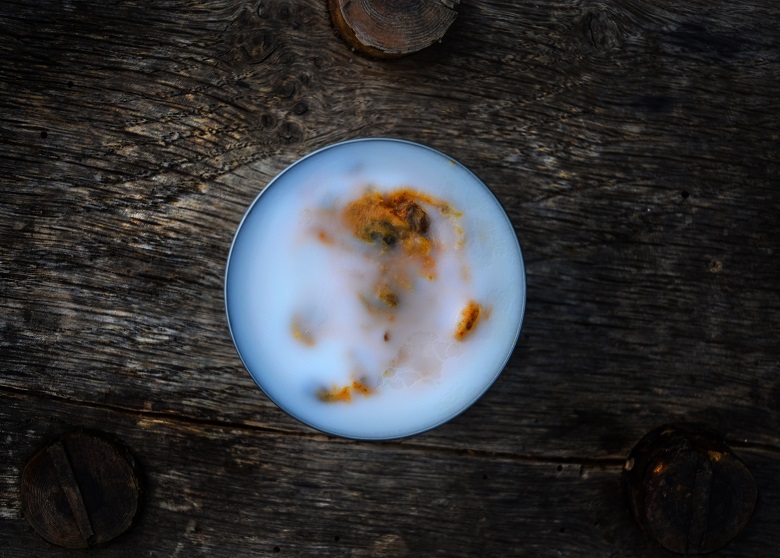
John Rae would recognise one of our dishes – but not some of the ingredients!
Orkney-born Rae is best known for discovering the grisly fate of the lost Franklin Expedition of 1845. He’s also the name behind our own Rae Project, which aims to digitally document every historic place and object in Historic Environment Scotland’s care.
Isobel Wylie Hutchison established herself as a trailblazing explorer of harsh terrains and as a botanist. She collected plants for the Royal Botanic Gardens and created important art, poetry and even an early documentary film recording her work.
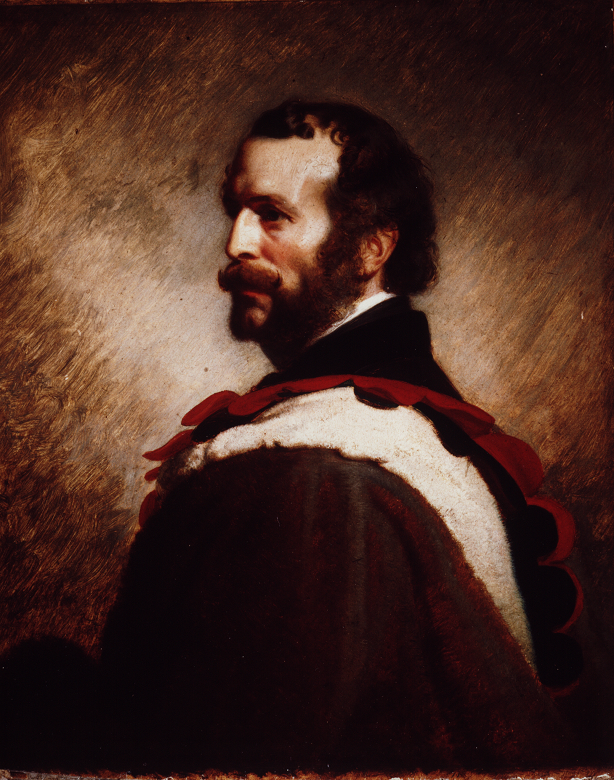 A replica of a portrait of Dr John Rae. The original was painted by Stephen Pearce in 1853 (Image from Scran)
A replica of a portrait of Dr John Rae. The original was painted by Stephen Pearce in 1853 (Image from Scran)
Unlike the monastic fish and chips and the medieval boiled eggs, which used authentic historical flavours and recipes, our pemmican is a 21st-century creation.
Accompanied by a totally fictitious “origin story”, It contains a mixture of haggis, lard, mustard, chilli, curry powder and just about anything we could find at the back of the kitchen cupboards! One clue that this recipe isn’t totally authentic is the inclusion of HP sauce – not invented until after John Rae’s death!
We told contestants that they were eating the same stuff that Rae and Hutchison carried on their travels – but that was fake news!
Did our contestants Taste the Truth?
Want to see what our contestants made of their mind-boggling menu? Did the manage to identify our made-up dish? You can watch Historic Fact or Fake News? below.
And if you want to try our dishes for yourself, we’ve include the recipes at the bottom of the page!
the Recipes for Our history-inspired dishes
Monastic Fish and Chips
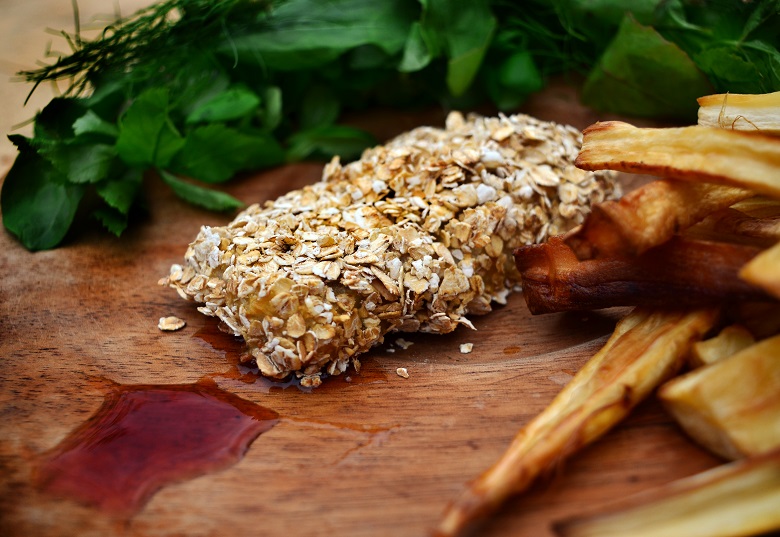
Ingredients
For the fish:
- 4 or 5 Fish fillets like cod or haddock but an oily fish like mackerel works well too
- 1 egg
- Salt & pepper to taste (though under strict Benedictine or Cistercian rule expensive spices like pepper were avoided though native herbs were used so if you are a forager you might replace the pepper with bittercress or cuckooflower (not to be confused with poisonous cuckoo pint)
- Large handful of rolled or pinhead oats
- Native herbs of your choice (optional)
For the chips:
- Handful of parsnips cleaned and sliced (Burdock stem pith, wild carrot or turnips would make a good alternative)
- 1 tbsp olive oil
For the Hawthorn “Ketchup”:
- 350g or so of hawthorn berries
- 120ml apple cider vinegar
- 120ml water
- 85g honey
- 60ml apple juice
- 1tsp sea salt
- Pinch of cardamom, allspice and cinnamon to taste (optional). This would probably not have been used by the monks but they may have been able to forage native spices from the likes of the wood avens root (also known as herb benedicta) which has a clove and cinnamon like taste. Hogweed seeds could replace cardamom and cuckoo flower or bittercresses would add a peppery taste.
To Make the Hawthorn Ketchup:
This is the most time-consuming part of the whole dish however the “ketchup” can be made in advance in the Autumn and kept up to a year in sterilized jars.
- First you need to remove the berries from the stalks and this can be used by pulling the berries through a fork or better still having been done when harvesting. Rinse in water to clean
- Put hawthorn berries in a large saucepan along with the water and apple cider vinegar. Bring to the boil then allow to simmer until they become soft and the skins start to fall apart (about 30mins)
- Strain the mixture through a strong sieve to separate the berry pulp from the stones (important as the stones like many fruit stones contains a type of cyanide plus they are fairly inedible). Make sure to retain both fruit and liquid together just discarding the hawthorn seeds
- Put your mixture back into a saucepan and add your honey and any spices you wish to use then heat slowly, stirring frequently, and bring the mix to a boil slowly
- Heat the mixture on a light boil for anywhere between 5 to 15mins until it starts to reach a syrupy consistency then remove from the heat
- Add the apple juice a little bit at a time till you start to get a consistency you are happy with (keep in mind it will thicken on cooling so err on the side of slightly runny)
- Pop the warm ketchup into sterilized jars to cool. Stored in the fridge this ketchup can be kept up to a month
To make the “Monk” Fish:
Benedictine and Cistercian monks often avoided using animal fats so this dish is made using the oven however it could also have been very carefully dry fried.
- Preheat your oven to 200c
- Whisk the egg in a bowl and set aside
- One at a time, coat the fish fillets in the egg on both sides, sprinkle with salt, then push into the oats on both sides. Repeat until all fish fillets are well coated
- Place the coated fish fillets on a baking tray and bake in the oven for about 10-15 minutes. Please note this time is variable depending on your oven and choice of fish fillets
To make the Parsnip Chips:
Originally these could have been baked in the ovens used to supply the daily bread to the abbey or by par boiling and then either dry frying on a skillet or charring over a fire. Here we will use a modern fire and a little oil (though the monks probably did not)
- Preheat your oven to 190c
- Slice your cleaned parsnips into chip sized length and toss in the oil then add to the oven dish. Sprinkle with a little salt if you so wish
- Bake for about 35 to 40mins until slightly golden and a fork meets little resistance when poked into the chips. Make sure to turn the chips part way through baking
- Serve hot with your oat crusted fish and homemade ketchup to enjoy your historical take on fish and chips!
Subtle But Exquisite Medieval Boiled Eggs
This recipe is sourced from a cookbook compiled by Geraert Vorselman and printed at Antwerp in 1560.
To make 8 eggs as a dessert for 8 guests

Ingredients
- 8 eggs
- 500ml almond milk (to be made from 300g ground almonds and 600ml water
- 1tsp saffron
- 5 tbsp and 2 tsp of sugar
- 8 sheets of colourless gelatine (7 grams each) or for a vegetarian option use 10 grams agar-agar flakes and if you want to be medieval authentic 34g isinglass (This can still be purchased from specialist stores. I was originally made from the gas/ swim-bladder of a sturgeon but now other fish are used.)
Method
- Eggshell preparation. This is a fiddly job but one that is essential to make your egg subtlety truly convincing in shape and texture. First break the raw eggs as straight as you can to end up with roughly 2/3rd large shell (the body) and 1/3rd small shell (the cap). Ideally, collect the raw egg and put to good use in another recipe. Rinse the eggshells and then leave them to dry. Try to keep the cap and body of each eggshell together to save confusion later when you will be playing jigsaw reassembling them
- Almond milk preparation. Boil the 600ml water and then allow to cool slightly before adding to the 300g ground almond and grind/blend for a minute or two. Leave the mix alone for 30mins then strain the almond milk through a fine sieve or muslin cloth. Keep both the liquid (your almond milk) and the leftover ground almonds which we will use later for the “yolk” of the eggs. You should have a yield of about 500ml almond milk
- Prepare the “egg whites”. Soften the gelatine by steeping the sheets in cold or tepid water for ten minutes. Add the 5tbsp sugar to the almond milk in a saucepan and heat over a low to medium heat (or beside the fire over low coals) stirring often to make sure sugar does not sink and burn. DO NOT LET THE MILK BOIL. Once sugar has dissolved remove from the heat. Squeeze excess water from the gelatine sheets and add to the milk stirring until they are incorporated.
(NOTE: If using agar-agar or isinglass this needs to be dissolved through boiling in the almond milk and constantly stirring) - Prepare the “egg yolks”. Take the leftover ground almonds and put in a bowl with 2tsp of sugar. Crush the saffron in 1tbsp hot water and add to the ground almonds then mix well. This should dye everything a convincing yolky yellow colour
- Eggshell stuffing. Originally the eggshells would have been stabilized in sand or salt but we can just stand them upright in their original egg carton (remember to keep each “cap” with the “body”. Pour the somewhat cooled almond milk into the “body” shells till they are each about half full. Wait for 30mins until the milk has coagulated. Form little balls of the yellow saffron ground almond mix and gently place into the middle of the half-filled shells. Heat the remaining almond milk until it is just pourable again (too hot and it risks melting the congealed mix making the yolk drop) and then fill the rest of the shell to the brim. Wait yet another 30mins and then fill the caps with the coagulated milk and gently press onto the body of each egg to create as smooth a fit as possible. Gently wipe away any excess “egg white”. Cool complete in the fridge before serving
- Store and serve. I recommend serving these in an egg cup with some biscuit “toast”. Peel very gently to avoid separating the layers. These “eggs” can be stored in the fridge for up to 3 days
Scots Explorer Pemmican

Whilst the recipe and story of “Scottish Pemmican” was made up, pemmican was not. It was originally developed from Native American traditional recipes in Canada during the 1700s and used by explorers all over the world. This is an example of a pemmican you can make at home to try, but be warned it is extremely calorific!
Ingredients
- 2kg lean mince (beef or venison works well)
- 1-2kg lard
- 250g or more of dried berries (cranberries are authentic)
Method
- First we need to dry the meat. To do this, cool your lean mince (it must be low in fat for health and safety reasons) in a fridge or freezer for an hour or so and slice thinly. Line some baking trays with parchment and spread your sliced meat on top. Bake in the oven at around 60 or 70c until dried and becoming brittle but not burnt. This may take several hours and should be checked often. Alternatively a dehydrator can be used set at around 60c
- If you have access to a food processer or a grinder then grind the meat to a powder but otherwise just try to break down into smaller pieces using a pestle and mortar (a lengthy process)
- Chop your dried berries into small pieces and mix with the ground/ powdered dried meat in a large bowl
- Melt the lard in a pot over a low heat. Combine with the dried meat and berries until all are well incorporated with one another
- Line a container, muffin tin or dish with baking paper. Press the pemmican mix firmly into it so it will be compressed when finished. Cut bar shapes (unless using muffin tin) but leave in the container
- Allow to cool in the fridge before enjoying with your fellow explorers! Note: Pemmican requires additional processing and sterilization to store safely for long term use. The pemmican created from this recipe should be used within 3 days. Store it in a cool dark place or a refrigerator.
Want to top off your meal with a sweet treat? Or maybe you want to match the dishes with a tipple?! Elsewhere on the blog you can recreate the Calanais Standing Stones in shortbread or take a cocktail-making class with Scottish whiskies and gins.

